Platja Sant Pol to Sant Feliu de Guixols
 This walk from Platja Sant Pol to Sant Feliu de Guixols in some ways is an extension to the walk between Platja d'Aro and S'Agaro. S'Agaro is just around the corner from our starting point at the beach of Sant Pol. Like S'Agaro, both Sant Pol and Sant Feliu were some of the earliest areas of the Costa Brava that were developed for tourism. Originally Sant Feliu de Guixols was a naval and ship-building town and important medieval port for the Costa Brava area. However as the fashion for water therapies developed, Sant Feliu opened its first spa in 1870 - but based on fresh water springs - not around the beach as such. The neighbouring area of Sant Pol was developed a little later and has a handful of Modernist villas in the style of Gaudi built around 1910-1915, just a little earlier than the development of S'Agaro.
This walk from Platja Sant Pol to Sant Feliu de Guixols in some ways is an extension to the walk between Platja d'Aro and S'Agaro. S'Agaro is just around the corner from our starting point at the beach of Sant Pol. Like S'Agaro, both Sant Pol and Sant Feliu were some of the earliest areas of the Costa Brava that were developed for tourism. Originally Sant Feliu de Guixols was a naval and ship-building town and important medieval port for the Costa Brava area. However as the fashion for water therapies developed, Sant Feliu opened its first spa in 1870 - but based on fresh water springs - not around the beach as such. The neighbouring area of Sant Pol was developed a little later and has a handful of Modernist villas in the style of Gaudi built around 1910-1915, just a little earlier than the development of S'Agaro.
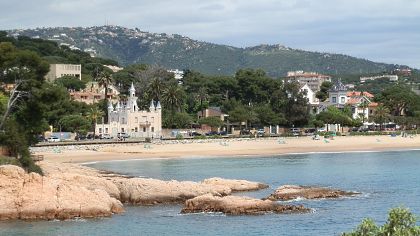 The main beach at Sant Pol is a wide sandy crescent with small hotels and the Modernist villas looking over the sand. The not particularly pretty connecting road between Sant Feliu and Platja d'Aro sits behind this area with no view over the sea, so it would be very easy to drive past and not realise there is one of the most romantic beaches on the Costa Brava a stone's throw away.
The main beach at Sant Pol is a wide sandy crescent with small hotels and the Modernist villas looking over the sand. The not particularly pretty connecting road between Sant Feliu and Platja d'Aro sits behind this area with no view over the sea, so it would be very easy to drive past and not realise there is one of the most romantic beaches on the Costa Brava a stone's throw away.
We start at the far end of the beach, almost at the point we started the return journey for the Platja d'Aro and S'Agaro walk. Along the start of the beach is a long run of brightly coloured beach huts but the weather this May has been relatively overcast with more rain than usual and though there are bursts of sun, the beach is empty apart from a group of children taking out canoes out on to the water.
 We follow the promenade along the front, passing the three main Modernista villas and the notice board explained when and how they were built. Like many Modernista buildings they are decorated with coloured glazed tiles making mosaics and pattens, with glazed tile roof parts. Two of the buildings are exceptionally well preserved (one is a restaurant), but the third and most notable, with a series of small turrets like a disney-style fantasy castle, is actually in a poor state of repair from close up, though it looks as work is being down for repairs.
We follow the promenade along the front, passing the three main Modernista villas and the notice board explained when and how they were built. Like many Modernista buildings they are decorated with coloured glazed tiles making mosaics and pattens, with glazed tile roof parts. Two of the buildings are exceptionally well preserved (one is a restaurant), but the third and most notable, with a series of small turrets like a disney-style fantasy castle, is actually in a poor state of repair from close up, though it looks as work is being down for repairs.
At the end of the beach the path runs out along the rocks of the headland - the GR92 again. To begin with it's very much a maintained footpath with walls to the rock edge and wooden beams helping create steps. However, as soon as you're off the main beach the views are remarkable with gold-coloured rocks and clear turquoise water inlets into tiny inaccessible beaches. Around the first headland is a tunnel made into the rocks, with an exit to the Mirador del Tunel from where you can look back over the Platja de Sant Pol across the rocks.
The path, though maintained, climbs up and down as it runs around and across the inlets climbing up to the road that connects the flats and houses above the bay. After we leave the road for the last time, the path turns more into the woods and is more of a natural trail almost feeling completely isolated from the surrounding houses. The path climbs up over the cliffs and we can see sea gulls nesting on the ledges, or seemingly sunbathing on the trees on the slopes below. The sun comes out again and sparkles on the water below.
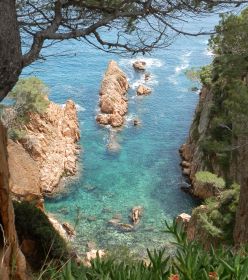 At the top, we reach another estate, before cutting down the back of the houses and further along the headland. Ahead of us is the port and bay of Sant Feliu. Historically, Sant Feliu is one of the important ports on the Costa Brava with a natural harbour and former shipyards and strong naval (and corsair piracy) connections. However, despite being one of the early spa towns on the Costa Brava and having a long promenade just off the beach with a long row of traditional bars and restaurants, it is not particularly touristy, the town behind the main beach area is mainly a sprawl of older residential terraced streets.
At the top, we reach another estate, before cutting down the back of the houses and further along the headland. Ahead of us is the port and bay of Sant Feliu. Historically, Sant Feliu is one of the important ports on the Costa Brava with a natural harbour and former shipyards and strong naval (and corsair piracy) connections. However, despite being one of the early spa towns on the Costa Brava and having a long promenade just off the beach with a long row of traditional bars and restaurants, it is not particularly touristy, the town behind the main beach area is mainly a sprawl of older residential terraced streets.
We take the path down from the cliffs and the viewpoint and emerge at a car park at the back of the port close to the fishing wharfs and large modern fishing boats. We follow the road around the corner and reach the main beach promenade. The town and restaurants on the first line from the sea are set back from the beach in the shade of tree-lined park.
Our route takes us along close to the beach. There are signs every so often explaining the history and naval exploits of the town in addition to old photographs of how the town looked pre-tourism. The beach has a long broad expanse of sand and fills up during summer, but with its position in the same bay as the port, it isn't a main beach location.
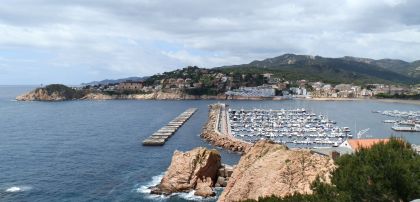 We follow the path around and along to the next headland. At the end of the headland is Hotel Eden Roc and the path should run around the back of the hotel. But for various reasons it seems closed. We do find a route around, though in places we feel we're walking in areas the hotel is claiming as its own private areas.
We follow the path around and along to the next headland. At the end of the headland is Hotel Eden Roc and the path should run around the back of the hotel. But for various reasons it seems closed. We do find a route around, though in places we feel we're walking in areas the hotel is claiming as its own private areas.
As we round the headland we can look south down the coast. In the distance we can see the white house and headland at Tossa de Mar. The connecting route from Tossa to Sant Feliu is notoriously bendy by road, and from the headland you can see the range of cliffs and hills between Tossa and Sant Feliu. For walking the Tossa - Sant Feliu route requires some planning as it's difficult to do in a round trip.
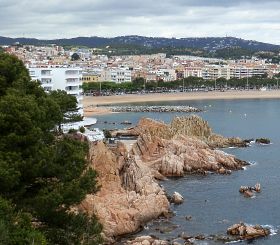 Around the headland we continue up and through the estates at the top of the headland. From here there are views back across Sant Feliu de Guixols, but the view is marred a little by one or two overlarge apartment blocks. As we've mentioned elsewhere, many of the historic towns in the Costa Brava have one, possibly two badly placed high-rises. It's not quite like Platja d'Aro which was almost made for tourism, but for historic towns like Sant Feliu (or La Bisbal) these badly sited high-rises can really diminish the town.
Around the headland we continue up and through the estates at the top of the headland. From here there are views back across Sant Feliu de Guixols, but the view is marred a little by one or two overlarge apartment blocks. As we've mentioned elsewhere, many of the historic towns in the Costa Brava have one, possibly two badly placed high-rises. It's not quite like Platja d'Aro which was almost made for tourism, but for historic towns like Sant Feliu (or La Bisbal) these badly sited high-rises can really diminish the town.
The path from the headland meets the road we started on, and so we double back. Rather than follow the path by the beach, we head into town. Despite being a Saturday, it's lunchtime, about 3pm, so the shops are pretty much closed and the streets are empty. We head out of town through the backstreets then out on the main road to Platja d'Aro. There are more hotels and built up buildings on the way out, but it also connects with the 'Ruta de Carrilet'. This is another former train route now converted into a bike path. This one though connects all the way to Girona (about 50km) and is the main Via Verde in the Costa Brava and well used by cyclists, either in part or taking the whole route.
The main road is not particularly attractive to walk on so we cut down past some holiday apartments and return to the beach of Platja de Sant Pol, just between the Modernista buildings. The children are still on the water, but now on stand-on surfboards balancing precariously as they paddle into the bay.
Neighbouring walks: Blanes, Lloret de Mar, Tossa de Mar by GR92 - Platja d'Aro and S'Agaro - Tossa de Mar north to Cala Pola - Sant Feliu de Guixols Pedralta - Solius, rocks for climbing and ruined castle
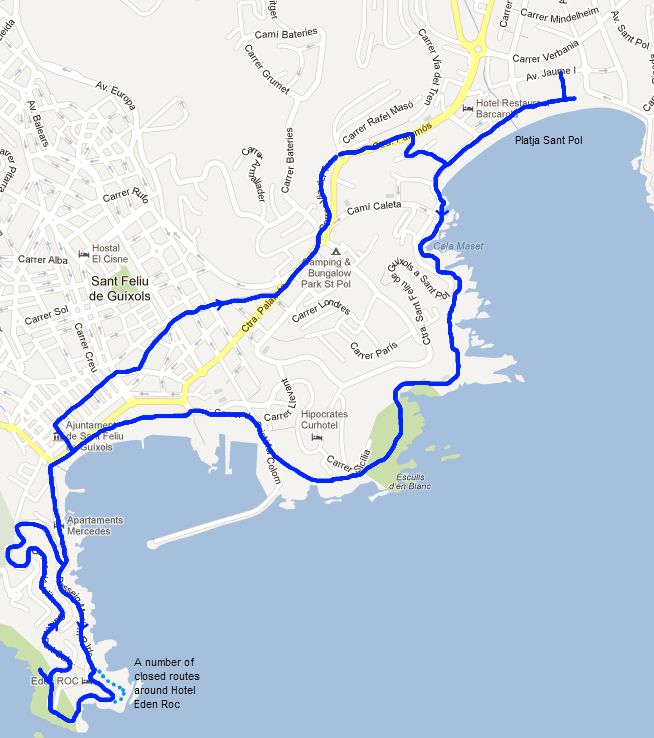

 Walks and other things
Walks and other things